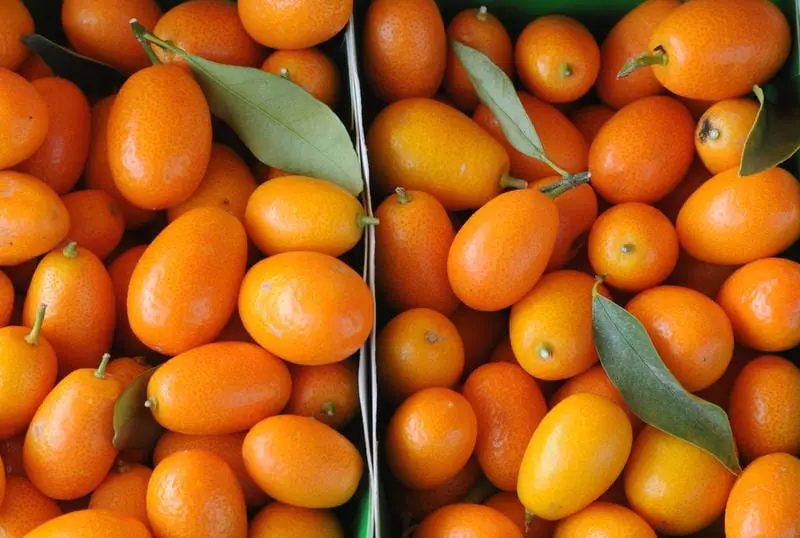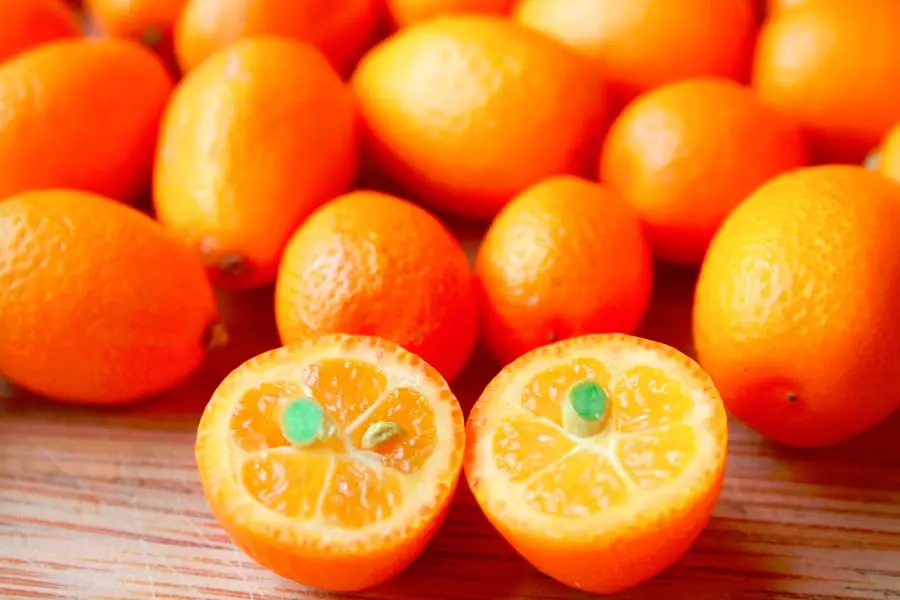Contents
Description
How many types of citrus do you know? Three? Five? What about 28? Indeed, in addition to the well-known orange, lemon, tangerine and grapefruit, this friendly family includes bergamot, pomelo, lime, clementine, kumquat and many others.
But there is a fruit in this row, past the fiery fruits of which it is very difficult to pass. This is a kumquat (also called kinkan, or Japanese orange).
This fruit is truly a darling of Mother Nature: in addition to its bright orange color, she awarded it with a strong pleasant aroma and unusual taste. Kumquat can be sweet or savory and sour; it is eaten with the skin – it is thin and has a slightly tart taste.
Fire fruits contain many useful substances – vitamins and essential oils.

In addition, they have bactericidal properties that have been used since ancient times in oriental medicine to treat fungal infections and respiratory diseases. Another important feature is that there are no nitrates in kumquat – they are simply incompatible with citric acid.
The piquant sourness makes the Japanese orange an original appetizer for spirits such as whiskey and cognac.
Composition and calorie content
There are several types of kumquat in nature, differing in the shape of the fruit. The calorie content of kumquat is 71 kcal per 100 grams of product. Kumquat contains many different vitamins such as A, C, E, B1, B2, B3, B5, B6, and is also rich in minerals such as potassium, calcium, phosphorus, zinc, magnesium, copper and iron.
- Calorie content, 71 kcal,
- Proteins, 1.9 g,
- Fat, 0.9 g,
- Carbohydrates, 9.4 g
Origin story

Homeland of kumquat – South Asia, the tree is widespread in the south of China, where the main share of the fruit in the world market is grown. The first documented mention of small orange fruits is found in Chinese literature of the 12th century AD.
The citrus plant was brought to Europe in 1846 by the famous collector of the exotic from the London Horticultural Society, Robert Fortune. Later settlers brought the tree to North America, where the fruits became known as fortunella in honor of the European discoverer.
Where it grows
Kumquat is grown in many countries of the world with warm, humid climates. The main supplier of fruit to the markets of Europe and Asia is the Chinese province of Guangzhou. The tree is cultivated in Japan, southern Europe, Florida, India, Brazil, Guatemala, Australia and Georgia.
What does the fruit look like
On the supermarket counter, you will immediately notice the kumquat. Fruits 1-1.5 wide and up to 5 centimeters long look like small oblong tangerines. They have a pronounced citrus aroma with a light coniferous note. The inside of the fruit contains a juicy pulp with 2-4 small seeds.
Kumquat taste
Kumquat tastes like a sweet and sour orange. The peel is very thin and edible, reminiscent of tangerine with a slight pleasant bitterness. During heat treatment, the fruit does not lose its taste, which makes it an excellent raw material for making all kinds of homemade preparations.

Useful properties of kumquat
This delicious citrus fruit contains 100 grams of vitamin C daily for a child and half for an adult. It is sold from mid-autumn to the end of winter, during the season of colds. Eating kumquat is useful for preventing influenza and acute respiratory infections and for enhancing immunity.
For everyone
- The fruit is rich in pectin and contains natural enzymes that are useful for normalizing the digestive tract in case of diarrhea and dysbiosis. Eating kumquat is essential for improving digestion and severe constipation.
- The fruits contain fiber, which, like a brush, cleanses the intestines of accumulated toxins and improves metabolism. Recommended on a weight loss diet, 3-5 fruits are eaten 20 minutes before breakfast with water.
- The use of kumquat reduces the risk of depression and nervous disorders, the pulp contains a balanced composition of minerals and essential oils that normalize the central nervous system.
- The fruit contains a substance called furocoumarin, which has antifungal properties. In case of inflammatory processes, it is recommended to eat kumquat as an additional medicine.
- Provitamin A in the pulp nourishes the eye muscle, prevents retinal inflammation and age-related changes associated with visual impairment. Regularly including kumquat in the diet, you can reduce the risk of cataracts by 3 times.
- For men
- Kumquat contains an optimal combination of beta-carotene and magnesium, helps to cleanse blood vessels and improve blood circulation, which is useful for increasing potency.
- The potassium in the fruit has a protective effect on the cardiovascular system and helps reduce swelling after intense gym work.
- The pulp contains carbohydrates and natural sugars, quickly energizes the body and is a great snack to replenish your strength after training.
For women
- On a slimming diet, kumquat is eaten in salads to cleanse the body of bad cholesterol and break down fats.
- Essential oils in the peel promote collagen production, improve the condition of the skin, hair and nails, and help regenerate the epidermis after cleansing the face.

For kids
- With a runny nose, cough and other manifestations of acute respiratory diseases, inhalation is carried out with brewed kumquat crusts. Essential oils penetrate the respiratory tract and effectively relieve inflammation caused by bacteria and viruses.
- For anemia, it is recommended to give children a kumquat. The fruit is rich in iron and manganese, which promote hematopoiesis and increase the amount of hemoglobin.
Harm and contraindications of kumquat
When you try the fruit for the first time, eat a small piece and wait 2-3 hours. If there is no allergic reaction, try the whole fruit.
Citrus fruit contains a large amount of organic acids, kumquat is harmful to people with gastrointestinal tract disorders.
Contraindications to use:
- acidity gastritis;
- pancreatitis;
- kidney disease;
- breast-feeding.
How to store kumquat
The peculiarity of citrus fruit is that the fruits are well stored and do not spoil for a long time. After purchasing, fold the kumquat into a plastic container and place in the refrigerator on the bottom shelf. At a temperature of 5-7 ° C, the fruit retains useful properties for up to 2 months.
Kumquat does not lose its taste even when frozen:
- dry thoroughly washed fruits, put them in a bag and freeze, store at a temperature of -18 ° C and below for up to 6 months, defrost them in the refrigerator before use, putting them on a plate;
- chop the washed fruits with a blender, add sugar to taste, pack the puree in plastic containers and store at -18 ° and below for up to 3 months.
- Candied fruits, jam, jam, compotes and other homemade preparations are made from kumquat.
Medical use

The main use of kumquat for treatment came to us from the recipes of oriental medicine. In China, many dietary supplements are prepared on the basis of essential oil obtained from the peel of the fruit. Also useful are tinctures and teas with the addition of kumquat.
- The whole dried fruits are brewed and make a healing tea for colds and to improve the functioning of the gastrointestinal tract.
- Dried kumquat peels are infused with alcohol. The drug is drunk for colds, diluted with water or mixed with fresh fruit puree.
- Tincture of kumquat on honey is used to purify blood, remove cholesterol plaques from the walls of blood vessels, and in the treatment of anemia.
- For a long time in Chinese medicine, fungal diseases have been treated by tying dried kumquat to the affected skin.
- Fresh kumquat juice is drunk to increase concentration, vitamin C in the composition perfectly tones and adds strength in case of chronic fatigue syndrome.
- Inhalations based on fresh or dried peel cleanse the bronchi and lungs from mucus, help with bronchitis, tonsillitis and other diseases of the upper respiratory tract.
- In many houses in China, housewives put dried kumquat around the house to disinfect the air and eliminate bacteria and viruses.









